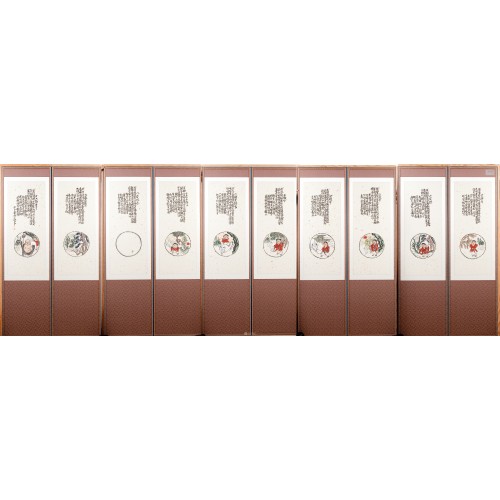본문
십우도(十牛圖)는 수행자가 본성을 깨닫는 과정을 잃어버린 소를 찾는 여정에 비유한 선화(禪畫)로, ‘심우도’ 혹은 ‘목우도’라고도 불립니다.
본래 도교의 팔우도에서 유래했으며, 두 단계를 더해 불교적 깨달음의 과정을 열 단계로 정립하게 됩니다.
소를 찾고 길들이는 초기 단계를 거쳐, 자아와 분별을 초월한 완전한 깨달음과 중생을 향한 실천의 단계까지 확장됩니다.
각 장면은 원형 구도 안에 그려져 마음의 본성을 상징적으로 드러내며, 동자의 표정과 자세 변화로 수행의 진전과 내면의 변화를 섬세하게 표현합니다.
오늘날에는 사찰 벽화나 선(禪) 관련 서화에서 자주 볼 수 있습니다.
■ 석정 스님 약력
1928 강원도 고성 신북면 출생
1940 송광사 출가
1941 김일섭 스님 문하 불화 수학
1969 서울·부산 《선서화전》 개최, 불교미술전람회 심사위원 활동
1976 부산 장전동 선주산방 건립 및 정착
1992 중요무형문화재 제48호 ‘단청장’ 지정
1995 『한국의 불화』 40권 발간 시작 (3,156점 수록)
2006 중요무형문화재 제118호 ‘불화장’ 지정
2007 『한국의 불화』 40권 발간 완료
2007 문화포장 수상, 서울·부산 《연묵전》 개최
2024 통도사 성보박물관에서 공개 시연 및 법문
2024 입적
2025 서울 세종문화회관 《석정전》 및 부산 국제문화회관 《석정전》 순회전 개최
2025 『석정서화집』, 『석정시문집』, 『한국의 불화』 출판기념회 개최
55년 이상, 전국 주요 사찰(송광사, 범어사, 통도사, 표충사, 봉암사 등) 불화 완성 및 조성 작업 참여
━━━━━
《十牛图》又称“寻牛图”或“牧牛图”,是一种以寻牛为喻,象征修行者追寻并觉悟本性的过程的禅画。
其起源可追溯至道教的《八牛图》,后吸收佛教思想,增补为十个阶段,系统描绘了从寻觅本性到证悟佛性,再到回归世间、利益众生的全过程。
画作依次呈现寻牛、得牛、牧牛、骑牛归家等阶段,最终进入忘牛存人、人与牛俱忘的超越境界,并回归凡尘。
各幅画面皆构图于圆形画框之内,象征圆满的心性。画中牧童的表情与姿态随修行进展而变化,细腻地传达内在精神层次的转化。
如今,《十牛图》广泛用于寺庙壁画及禅宗相关书画中。
■ 石鼎僧人 介绍
1928年 出生于韩国江原道高城郡新北面
1940年 于松广寺出家
1941年 师从金日燮僧人,学习佛教绘画技艺
1969年 在首尔与釜山举办《禅书画展》,并担任佛教美术展览会评审委员
1976年 在釜山长箭洞建立“禅主山房”,定居于此,潜心佛画创作
1992年 被指定为韩国重要非物质文化遗产第48号“丹青匠”
1995年 启动《韩国佛画》40卷大型图录编纂工程(共收录3,156件作品)
2006年 被追加指定为韩国重要非物质文化遗产第118号“佛画匠”
2007年 《韩国佛画》全40卷编纂完成
2007年 荣获文化褒章,并于首尔与釜山举办《烟默展》
2024年 于通度寺圣宝博物馆举行公开示范与法语开示
2024年 入寂
2025年 在首尔世宗文化会馆与釜山国际文化会馆举办《石鼎展》巡回展
2025年 举行《石鼎书画集》、《石鼎诗文集》、《韩国佛画》出版纪念会
在长达55年以上的艺术生涯中,石鼎僧人参与并主导了韩国众多主要寺院(如松广寺、梵鱼寺、通度寺、表忠祠、凤岩寺等)的佛画绘制与重修工程
━━━━━
The Ten Ox-Herding Pictures (Sipudo, 十牛圖) is a Zen Buddhist painting that allegorically portrays the path to enlightenment through the journey of searching for and taming a lost ox. It is also known as Simudo or Mokudo.
It originated from the Taoist Eight Ox-Herding Pictures (Paludo) and was later expanded into ten stages to reflect a Buddhist framework for spiritual awakening.
The ten images illustrate stages from the initial search and taming of the ox to transcending ego and duality, culminating in enlightenment and compassionate action toward others.
Each scene is drawn within a circular composition symbolizing the mind’s essence, and the expressions and postures of the young herder sensitively depict the inner transformation and progress of practice.
Today, this motif is commonly found in temple murals and Buddhist artworks associated with Zen.
■ Biography of Monk Seokjeong
1928: Born in Sinbuk-myeon, Goseong, Gangwon-do
1940: Ordained at Songgwangsa Temple
1941: Studied Buddhist painting under Monk Kim Il-seop
1969: Held Zen Calligraphy and Painting Exhibition in Seoul and Busan; served as judge for Buddhist Art Exhibition
1976: Built and settled at Seonju Hermitage in Jangjeon-dong, Busan
1992: Designated as Important Intangible Cultural Heritage No. 48 (Dancheong Artisan)
1995: Began publication of Buddhist Paintings of Korea (40 volumes, 3,156 works cataloged)
2006: Designated as Important Intangible Cultural Heritage No. 118 (Buddhist Painting Artisan)
2007: Completed publication of Buddhist Paintings of Korea (40 volumes)
2007: Received the Order of Cultural Merit; held Yeonmuk Exhibition in Seoul and Busan
2024: Gave a public demonstration and Dharma talk at the Tongdosa Seongbo Museum
2024: Passed away
2025: Touring Seokjeong Retrospective held at Seoul Sejong Center and Busan International Cultural Center
2025: Publication ceremonies for Collected Calligraphy and Paintings of Seokjeong, Collected Poems of Seokjeong, and Buddhist Paintings of Korea
For over 55 years, Monk Seokjeong participated in the creation and restoration of Buddhist paintings at major temples across Korea, including Songgwangsa, Beomeosa, Tongdosa, Pyochungsa, and Bongamsa.

